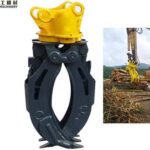Excavator wood grab is a hydraulic attachment designed specifically for handling logs, timber, and other wooden materials. Mounted onto the arm of an excavator, it replaces traditional buckets or other tools, offering specialized functionality for gripping and maneuvering wood. The device typically consists of two or more rugged steel jaws equipped with sharp teeth or clamps that securely grasp logs of varying sizes and weights. Its hydraulic system allows operators to control the grip force and opening width, ensuring adaptability to different tasks.
Components of an Excavator Wood Grab
- Hydraulic Cylinders: Powered by the excavator’s hydraulic system, these cylinders control the opening and closing of the grab’s tines.
- Tines/Claws: Durable, reinforced steel prongs that penetrate and secure loads.
- Mounting Bracket: A universal or machine-specific bracket that connects the grab to the excavator’s arm.
- Rotator Mechanism (Optional): Allows 360-degree rotation for enhanced maneuverability.
Applications of Wood Grab Attachment
The versatility of an excavator wood grab makes it indispensable across multiple industries:
- Forestry and Logging
Log Handling: Efficiently load, unload, and stack logs at mills or storage yards.
Clearing Debris: Remove fallen trees, stumps, and brush after harvesting or storms.
Thinning Operations: Selectively remove smaller trees to improve forest health. - Construction and Demolition
Site Clearance: Remove trees, shrubs, and roots to prepare building sites.
Demolition Debris Management: Sort and transport scrap wood, reducing landfill waste.
Landscaping: Position large rocks, boulders, or ornamental logs with precision. - Agricultural Use
Fence Post Installation: Dig holes and position wooden posts in rural areas.
Biomass Handling: Transport wood chips or pellets for bioenergy production.
Advantages Of Using An Excavator Wood Grabber
Enhanced Efficiency
The wood grab consolidates tasks into a single operation, significantly speeding up workflows.
Improved Safety
The wood grab’s remote-controlled operation keeps workers at a safe distance while maintaining precise control over loads.
Cost Savings
By reducing labor requirements and minimizing damage to logs, thanks to adjustable grip pressure.
Maintenance Tips For Longevity
Proper maintenance ensures your Excavator Wood Grab remains reliable over time:
- Regularly inspect hydraulic hoses and connections for leaks.
- Lubricate pivot points and joints to prevent rust and ensure smooth movement.
- Clean the jaws after use to remove sap, dirt, or debris that could impair functionality.
- Check teeth for wear and replace them promptly to maintain grip efficiency.
- Store the attachment in a dry, covered area when not in use.
How to Choose the Right Excavator Wood Grab?
- Excavator Size and Capacity
Match the grab’s weight and hydraulic requirements to your machine’s specifications.
Overloading the excavator can damage components and compromise safety. - Material Density and Size
Heavy-duty grabs are essential for large logs or dense hardwoods.
Lightweight grabs suffice for softwoods, green waste, or agricultural applications. - Tine Configuration
Opt for multi-tine designs if handling irregularly shaped loads.
Single-tine grabs excel in piercing and dragging tasks. - Rotational Needs
A rotating grab is indispensable for applications requiring precise placement, such as stacking logs in a mill.


